Table of Contents
10
Before you read
Have you seen a mongoose? You have read in Lesson 9 that a mongoose can fight with and kill a snake. Look at the pictures and read the lines given along with them.
The Banyan Tree
The fight of the cobra and the mongoose is a classic drama often seen in India, and the outcome is largely the same. The mongoose is not immune to the venomous bite, but is faster and quicker in motion than the snake. The cobra assumes a posture of defence and attempts to reach the animal by a sweeping strike, but the quick-moving mongoose jumps out of reach and comes at the snake from another direction, before the snake can get into striking position again.
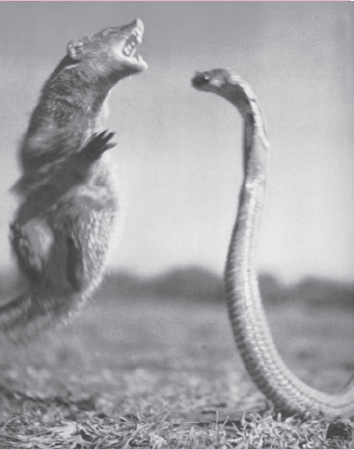
This constant movement tires and discourages the snake, and the mongoose is finally able to leap in close and bury its teeth in the snake’s neck, usually severing the joints of its vertebrae.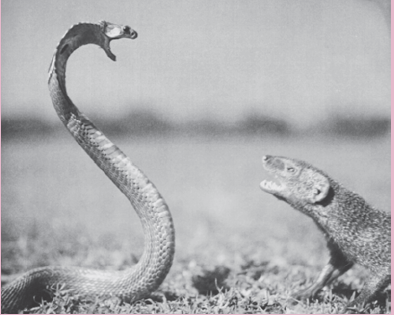
• You must have seen a banyan tree. This is a story about what the author saw, as a young boy, when he was sitting in an old banyan tree in his grandfather’s house.
Part I
1. Though the house and grounds belonged to my grandparents, the magnificent old banyan tree was mine — chiefly because Grandfather, at sixty-five, could no longer climb it.
2. Its spreading branches, which hung to the ground and took root again, forming a number of twisting passages, gave me endless pleasure. Among them were squirrels and snails and butterflies. The tree was older than the house, older than Grandfather, as old as Dehra Dun itself. I could hide myself in its branches, behind thick green leaves, and spy on the world below.
spy: watch secretly
3. My first friend was a small grey squirrel. Arching his back and sniffing into the air, he seemed at first to resent my invasion of his privacy. But when he found that I did not arm myself with catapult or air gun, he became friendly, and when I started bringing him pieces of cake and biscuit he grew quite bold and was soon taking morsels from hand. Before long, he was delving into my pockets and helping himself to whatever he could find. He was a very young squirrel, and his friends and relatives probably thought him foolish and headstrong for trusting a human.
resent: dislike; feel angry about
morsels: small pieces of food
delving: going deep into

4. In the spring, when the banyan tree was full of small red figs, birds of all kinds would flock into its branches: the red-bottomed bulbul, cheerful and greedy; parrots, myna and crows squabbling with one another. During the fig season, the banyan tree was the noisiest place in the garden.
during the fig season: the time when figs appeared
5. Halfway up the tree I had built a crude platform where I would spend the afternoons when it was not too hot. I could read there propping myself up against the tree with a cushion from the living room. Treasure Island, Huckleberry Finn and The Story of Dr Dolittle were some of the books that made up my banyan tree library.
6. When I did not feel like reading, I could look down through the leaves at the world below. And on one particular afternoon I had a grandstand view of that classic of the Indian wilds, a fight between a mongoose and a cobra.
grandstand view: a clear view from the best position (a grandstand is a large covered space with rows of seats for people to watch sports)
Part II
7. The warm breezes of approaching summer had sent everyone, including the gardener, into the house. I was feeling drowsy myself, wondering if I should go to the pond and have a swim with Ramu and the buffaloes, when I saw a huge black cobra gliding out of a clump of cactus. At the same time a mongoose emerged from the bushes and went straight for the cobra.
gliding: moving smoothly
clump: group (of bushes or trees)
emerged: came out
8. In a clearing beneath the banyan tree, in bright sunshine, they came face to face. The cobra knew only too well that the grey mongoose, three feet long, was a superb fighter, clever and aggressive. But the cobra, too, was a skilful and experienced fighter. He could move swiftly and strike with the speed of light; and the sacs behind his long sharp fangs were full of deadly poison. It was to be a battle of champions.
clearing: an open space in a forest where there are no trees
sacs: a part (of an animal or plant) shaped like a bag
fangs: long sharp teeth (of a snake or dog)
9. Hissing defiance, his forked tongue darting in and out, the cobra raised three of his six feet off the ground, and spread his broad, spectacled hood. The mongoose bushed his tail. The long hair on his spine stood up.
defiance: rebellion; resistance
dart: move quickly, suddenly
10. Though the combatants were unaware of my presence in the tree, they were soon made aware of the arrival of two other spectators. One was a myna, the other a jungle crow. They had seen these preparations for battle, and had settled on the cactus to watch the outcome. Had they been content only to watch, all would have been well with both of them.
combatants: participants in a fight
spectators: those who watch a show, a game, etc.
outcome: result

11. The cobra stood on the defensive, swaying slowly from side to side, trying to mesmerise the mongoose into making a false move. But the mongoose knew the power of his opponent’s glassy, unwinking eyes, and refused to meet them. Instead he fixed his gaze at a point just below the cobra’s hood, and opened the attack.
mesmerise: here, magically persuade
a false move: an unwise action
12. Moving forward quickly until he was just within the cobra’s reach, the mongoose made a pretended move to one side. Immediately the cobra struck. His great hood came down so swiftly that I thought nothing could save the mongoose. But the little fellow jumped neatly to one side, and darted in as swiftly as the cobra, biting the snake on the back and darting away again out of reach.
13. At the same moment that the cobra struck, the crow and the myna hurled themselves at him, only to collide heavily in mid-air. Shrieking insults at each other they returned to the cactus plant. A few drops of blood glistened on the cobra’s back.
glistened: shone
14. The cobra struck and missed. Again the mongoose sprang aside, jumped in and bit. Again the birds dived at the snake, bumped into each other instead, and returned shrieking to the safety of the cactus.
15. The third round followed the same course as the first but with one dramatic difference. The crow and the myna, still determined to take part in the proceedings, dived at the cobra; but this time they missed each other as well as their mark. The myna flew on and reached its perch, but the crow tried to pull up in mid-air and turn back. In the second that it took the bird to do this the cobra whipped his head back and struck with great force, his snout thudding against the crow’s body.
round: here, a stage in a fight or competition
pull up: here, stop
whipped...back: moved...back suddenly
snout: the nose and mouth of an animal

16. I saw the bird flung nearly twenty feet across the garden. It fluttered about for a while, then lay still. The myna remained on the cactus plant, and when the snake and the mongoose returned to the fight, very wisely decided not to interfere again! The cobra was weakening, and the mongoose, walking fearlessly up to it, raised himself on his short legs and with a lightning snap had the big snake by the snout. The cobra writhed and lashed about in a frightening manner, and even coiled itself about the mongoose, but to no avail. The little fellow hung grimly on, until the snake had ceased to struggle. He then smelt along its quivering length, gripped it round the hood, and dragged it into the bushes.
to no avail: with no success
17. The myna dropped cautiously to the ground, hopped about, peered into the bushes from a safe distance, and then, with a shrill cry of congratulation, flew away.
Ruskin Bond
[slightly abridged]
Working with the text
A. Complete the following sentences.
1. The old banyan tree “did not belong” to grandfather, but only to the boy, because ——————————————————————————————
2. The small gray squirrel became friendly when ——————————————————————————————————
3. When the boy started to bring him pieces of cake and biscuit, the squirrel ——————————————————————————————————
—————————————————————————————————
4. In the spring, the banyan tree —————————————–, and
—————————————– would come there.
5. The banyan tree served the boy as a —————————————–—–
——————————————————————————————————
6. The young boy spent his afternoons in the tree ————————–—————————————–—————————————–———–––—
B. Answer the following questions.
1. “It was to be a battle of champions.”(8)
(i) What qualities did the two champions have? Pick out words and phrases from the paragraph above this line in the text and write them down.

(ii) What did the cobra and the mongoose do, to show their readiness for the fight?
2. Who were the other two spectators? What did they do? (Did they watch, or did they join in the fight?) (10)
3. Read the descriptions below of what the snake did and what the mongoose did. Arrange their actions in the proper order. (11, 16)
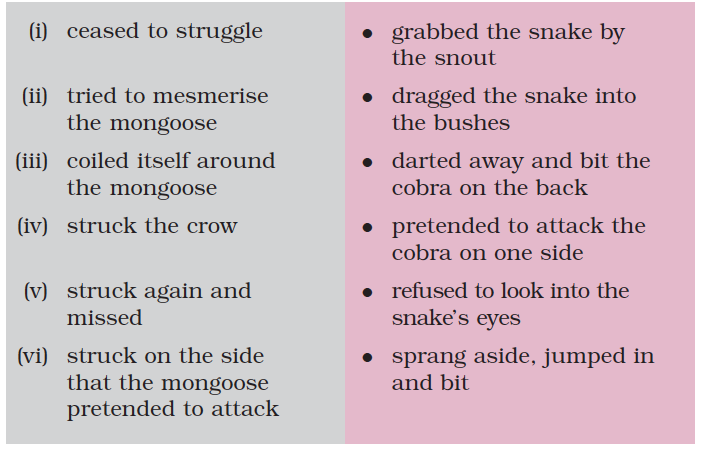
4. (i) What happened to the crow in the end? (16)
(ii) What did the myna do finally? (17)
Working with Language
A. 1. The word ‘round’ usually means a kind of shape. What is its meaning in the story?
2. Find five words in the following paragraph, which are generally associated with trees. But here, they have been used differently. Underline the words.
Hari leaves for work at nine every morning. He works in the local branch of the firm of which his uncle is the owner. Hari’s success is really the fruit of his own labour. He is happy, but he has a small problem. The root cause of his problem is a stray dog near his office. The dog welcomes Hari with a loud bark every day.
B. The words in the box are all words that describe movement. Use them to fill in the blanks in the sentences below.
dived gliding sprang darting
whipped...back delving
1. When he began to trust me, the squirrel began ————————— into my pockets for morsels of cake.
2. I saw a cobra ——————————— out of a clump of cactus.
3. The snake hissed, his forked tongue ———————— ———— in and out.
4. When the cobra tried to bite it, the mongoose —————————— aside.
5. The snake ——————————— his head ——————————— to strike at the crow.
6. The birds ——————————— at the snake.
C. Find words in the story, which show things striking violently against each other.
1. The cobra struck the crow, his snout th — — — ing against its body. (15)
2. The crow and the myna c — ll — — — — in mid-air. (13)
3. The birds dived at the snake, but b — — — — d into each other instead. (14)
D. Look at these sentences.
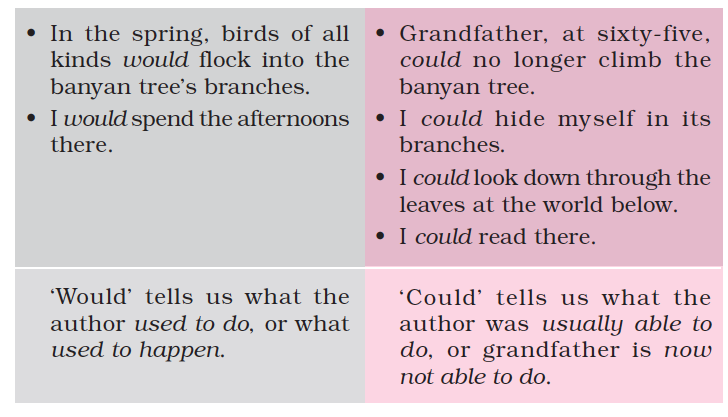
Choose would and could to replace the italicised words in the following sentences.
Grandfather says, in the old days,
1. elephants were able to fly in the sky, like clouds. They were also able to change their shapes. They used to fly behind clouds and frighten them. People used to look up at the sky in wonder.
2. because there was no electricity, he used to get up with the sun, and he used to go to bed with the sun, like the birds.
3. like the owl, he was able to see quite well in the dark. He was able to tell who was coming by listening to their footsteps.
Speaking
Look at these sentences.
• The tree was older than Grandfather.
• Grandfather was sixty-five years old.
How old was the tree? Can you guess?
• The tree was as old as Dehra Dun itself.
Suppose Dehra Dun is 300 years old. How old is the tree?
When two things are the same in some way, we use as...as.
Here is another set of examples.
• Mr Sinha is 160 centimetres tall.
• Mr Gupta is 180 centimetres tall.
• Mrs Gupta is 160 centimetres tall
Mrs Gupta is as tall as Mr Sinha.
Use the words in the box to speak about the people and the things below, using as...as or -er than
tall – taller cold – colder hot – hotter
strong – stronger short – shorter
(Notice that in the word ‘hot’, the letter ‘t’ is doubled when -er is added.)
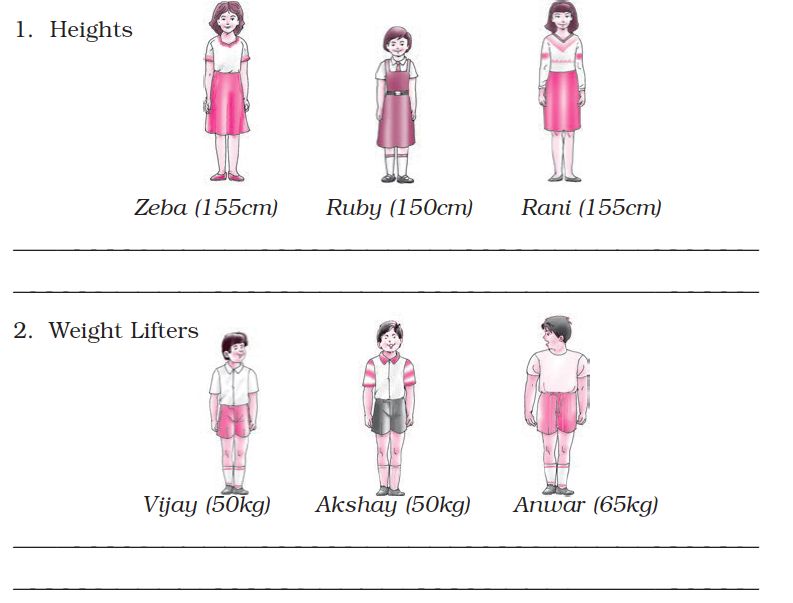
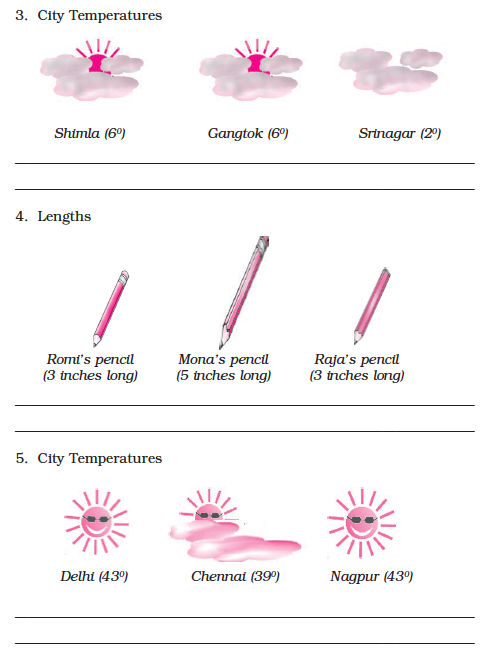
Writing
‘My Favourite Place’
Read again the paragraphs of the story in which the author describes the banyan tree, and what he used to do there. Is there a place in your house, or in your grandparents’ or uncles’ or aunts’ houses, that you specially like? Write a short paragraph about it, saying
• where it is
• what you do there
• why you like it
You may instead write about a place you dislike, or are afraid of.
Know Your Country
Answers
1. The Mahanadi.
Measuring 4800 metres, the Hirakud Dam is the largest in the country.
2. Tamil Nadu.
The merger of the Arabian sea, the Bay of Bengal and the Indian ocean at this point is an unforgettable spectacle.
3. Ten Degree Channel.
